While in Washington D.C. to judge in the Whiskey and Gin Categories for the World Drinks Award, we spend several days visiting wineries, distilleries, breweries, and cideries in the Metropolitan area. Interestingly, while traveling from Frederick Maryland in the northwest to Fredericksburg Virginia in the south and to Leonardtown, Maryland in the East, our tour evolved into a journey back in time when America was the center of Rum production. Along the way we visited four distilleries that focus exclusively on distilling Rum as well as excellent Rum expressions at two other distillers. In addition, we visited three other Maryland distilleries as well as other friends in the cider, beer, and wine sectors.

Cotton & Reed is a distillery and cocktail bar located in Washington D.C.’s Union Market where they have been producing award-winning rum for the past seven years. Their rums are made using cane syrup and molasses from one of only two BONSUCRO-certified sugar refineries in the United States. Bonsucro is a global sustainability platform and standard for the production and use of sugarcane. During this visit we sampled through their standard expressions as well as a vertical tasting of their Solera Scorpio sherry finished rums. These are very clean and well-made products, starting with the White Rum and a slight grassy profile. The Gold Rum spends a year in used bourbon barrels and provides honey and vanilla notes.
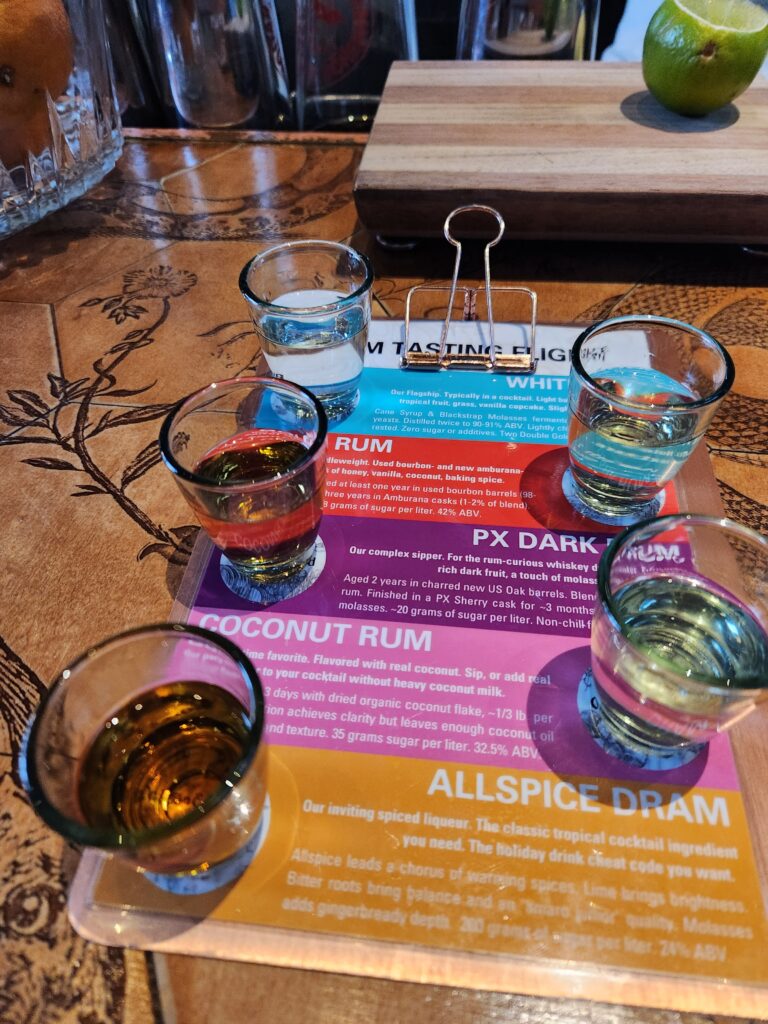
The PX Dark Rum rests 18 months in new American Oak barrels before finishing in a re-seasoned 500L PX Sherry Butt. This is very complex, with a full mouthfeel of various flavors from dried fruit, nuts, vanilla, and sweet honey. The Coconut Rum is one of the best we’ve tasted. Instead of chemical coconut, the rum leaps with fresh toasted coconuts based on the dried organic coconut flakes. Next, we moved to the vertical of Solera rums — the 2020, 2022, and 2023 Solera Scorpio. In general, the rums were aged up to two years in used bourbon barrels, then moved into PX Sherry-seasoned barrels, and finally blended into a giant 450-liter Armagnac cask for a year. They all share a nuttiness and honeyed fig profile with varying degrees of intensity. If any of these are within your budget, they are highly recommended.
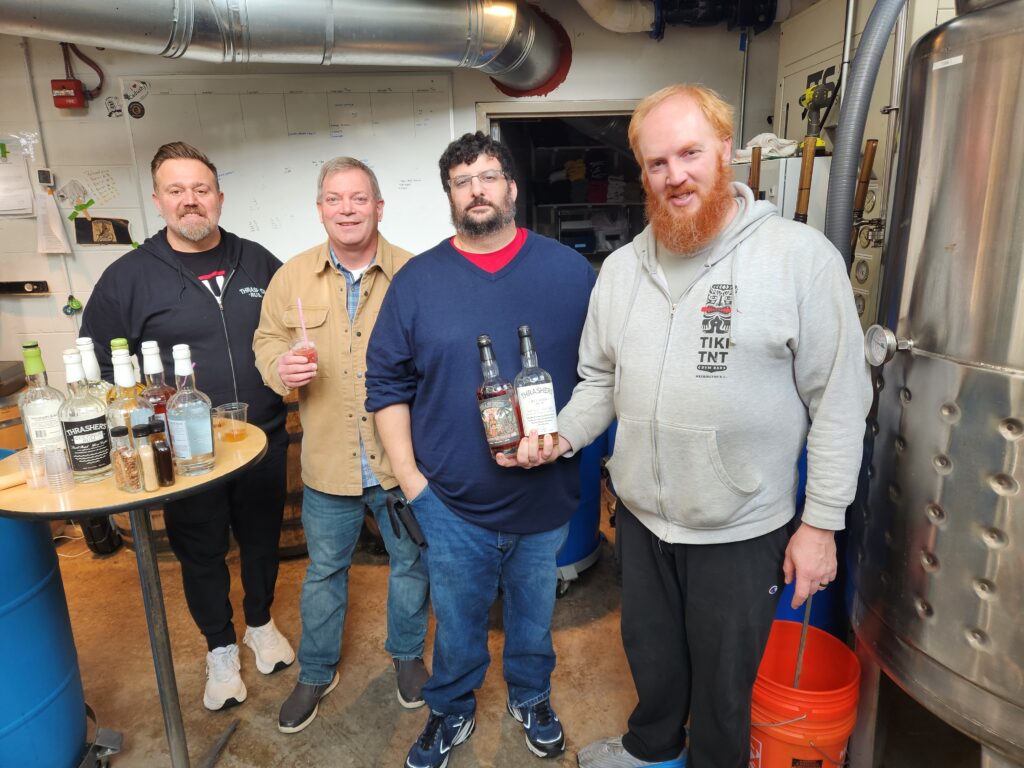
Thrasher’s Rum is produced at the DC’s District Wharf and served upstairs at the Tiki TNT bar. The distillery was founded by Todd Thrasher based on his love of Guyanese-style rum. (Guyana rums are very fruity and rich – among the fullest in body of all Caribbean rums. The area is known for the famed Demerara River where the rich Demerara sugar is renowned for its high quality and contributes a unique caramel-like sweetness to the rum.) Along with Justin Owens, the duo produces an interesting range of rums by fermenting equal parts black strap molasses and raw turbinado sugar (sourced from Louisiana) and distilling using a pot still. Depending on the recipe the rum is distilled a second time through a column still and adding a botanical basket if necessary. The rum is proofed down to 40% ABV using a steady drip from their water filtration system.
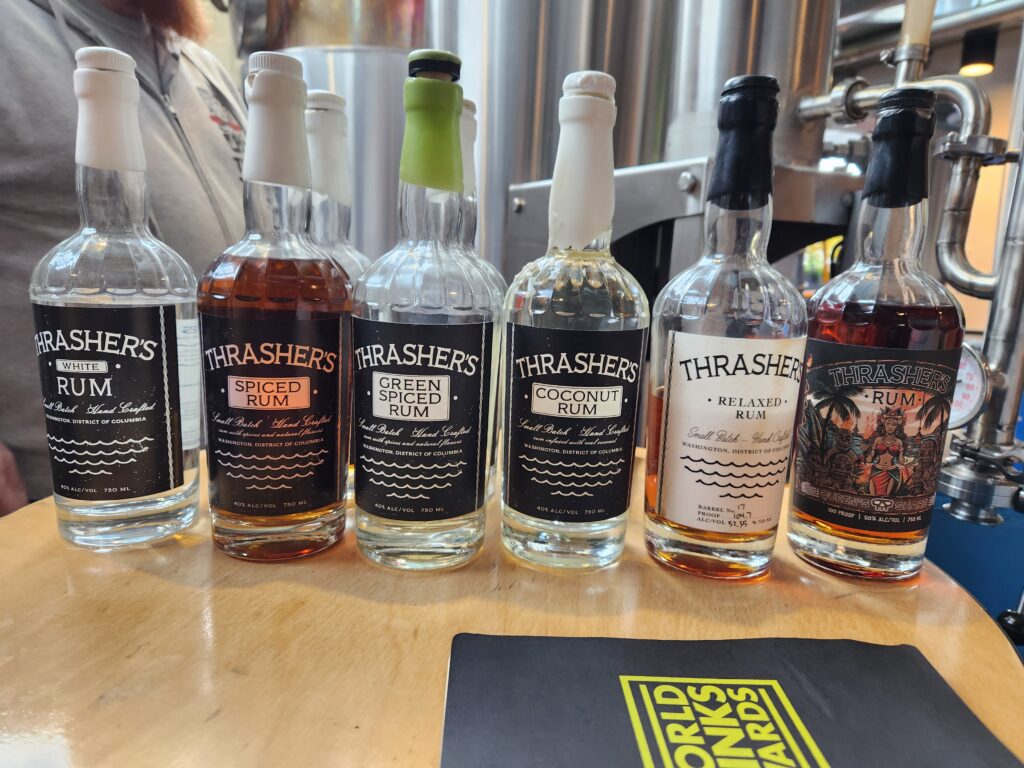
White: This is a very clean rum, grassy and cane aromas leading to a honey profile. Spiced: The White Rum is steeped with star anise, clove, cinnamon, vanilla, and orange peels. The baking spices and vanilla stand out with a long pleasant finish. Green Spiced: Thrasher’s Green Spiced Rum is a one of a kind spirit creatively infusing botanicals and spices using a botanical basket. These include lemon verbena, lemongrass, lemon balm, mint, green cardamom, and lime peels, and builds a juniper-less spiced gin profile. Looking forward to experimenting with several cocktails. Coconut: This rum is created by steeping 60 pounds of raw coconut in the White Rum overnight, then loading the botanical basket with five pounds of toasted coconut for a column run Then an additional five pounds of dehydrated coconut is steeped for four more days. The toasted and fresh coconut flavors are unreal. Excellent. Gold: This rum is made by aging the White Rum for sic months in medium char, medium tasted New American Oak barrels. A solid offering.

Copper Compass Craft Distilling Co. is the handiwork of cousins Board-certified pediatric dentist April Toyer and retired U.S. Navy command master chief Herb Banks. The distillery is located outside of Waldorf Maryland in White Plains and focuses on craft rum – a very suitable decision based on Banks’ Navy career. The name “Copper Compass” also combines this career with the history of our American predecessor’s distilling operations. Herb also built out most of the facility from the beautiful wood bar made from wood reclaimed from a 200 year old barn to the graphics displaying the distilling process.
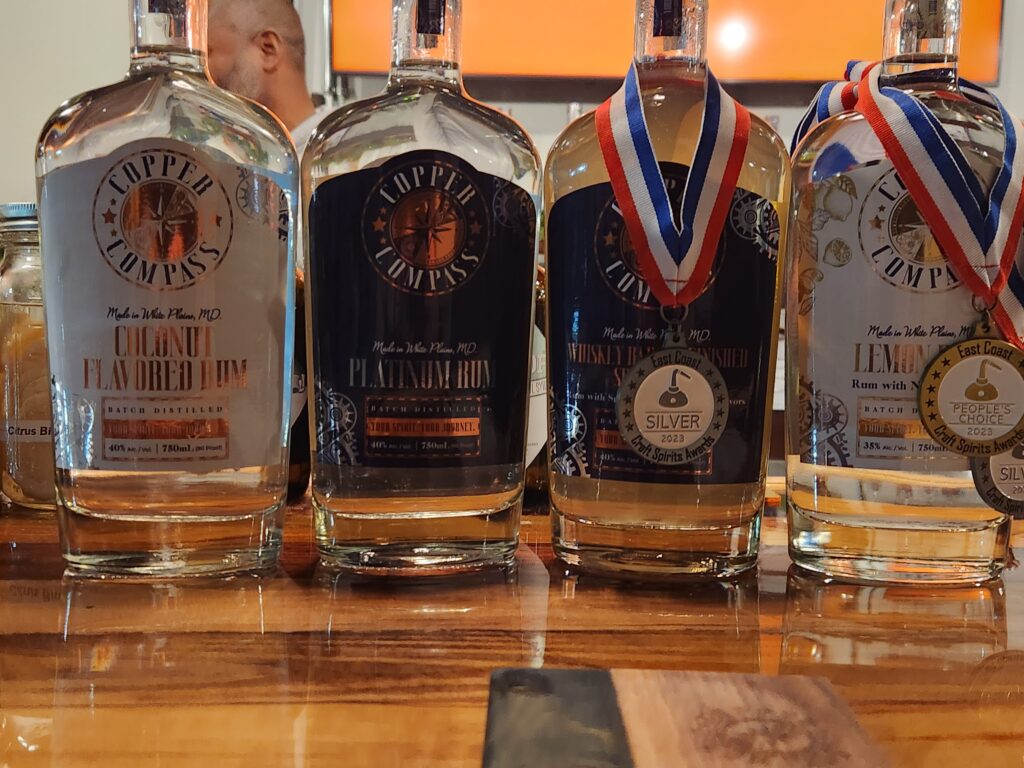
Currently the distillery offers four styles of rum starting with a very clean yet funky Platinum rum made from home-made molasses. The Coconut Rum starts with the Platinum as a base and then is seeped with real toasted coconut. This is evident by the pure coconut flavors as opposed to any chemical solution. The Whiskey Barrel Spiced Rum is another expression that is complex without any artificial characteristics. Their Platinum Rum rests in a spirit tank and spiced with seven different natural spices along with staves from a Charred Oak American Barrel. The spices are all of the place (vanilla, clove, ginger, orange peel, all spice, black pepper, star anise, and cinnamon spice) with the oak imparting more vanilla and accentuating the cane sugar sweetness. Looking forward to trying this one at home. Finally, they offer the Lemon Drop Rum made with natural lemon flavor. This expression is definitely refreshing leaving a clean sweet finish.
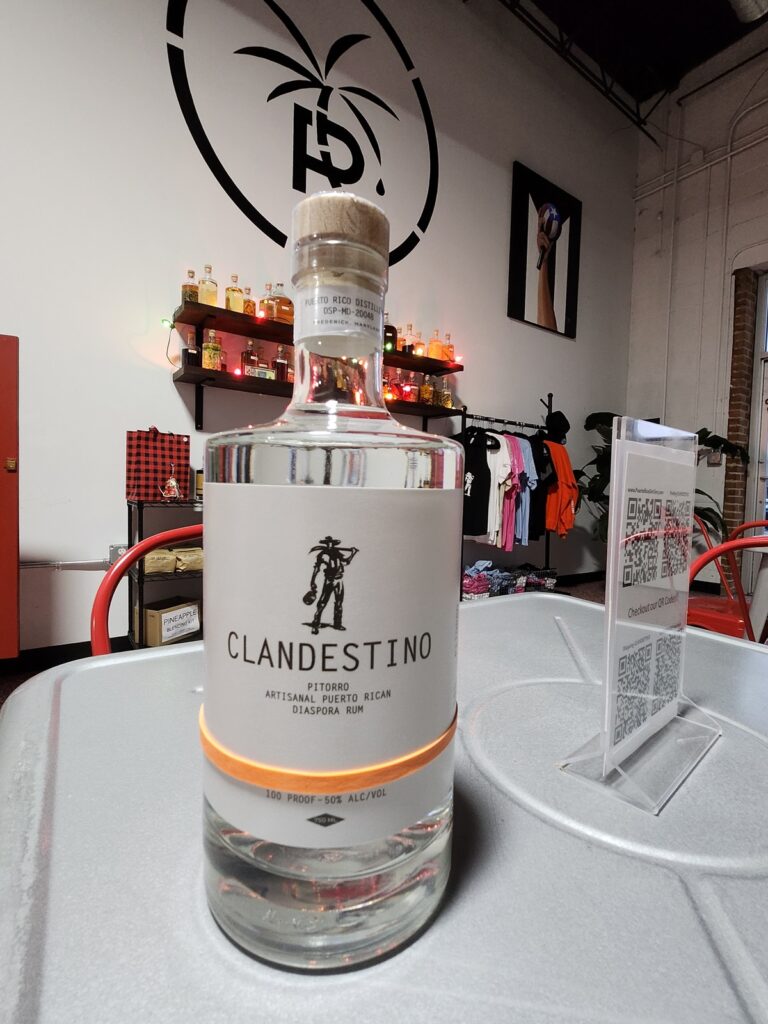
Pitorro is Puerto Rican moonshine — sometimes an artisan rum produced by distilling sugar cane and traditionally cured with fruit and buried for several months. This process helps to balance the high alcohol volume. And Puerto Rico’s unofficial national spirit is now available in the Old Line State courtesy of Frederick’s Puerto Rico Distillery. The distillery is led by the father-daughter team of Angel and Crystal Rivera and their portfolio starts with an unflavored pitorro weighing in at 100 proof. This spirit is distilled from sugarcane molasses and has a funky character. They are also aging batches infused with coconut, coconut chai, pineapple, pineapple ginger, almond, butter pecan, coffee, and kiwi. Loads of interesting expressions especially their Traditional which is a Puerto Rico tradition infused with raisins, prunes, and cranberries. Imagine all the cocktail recipes…
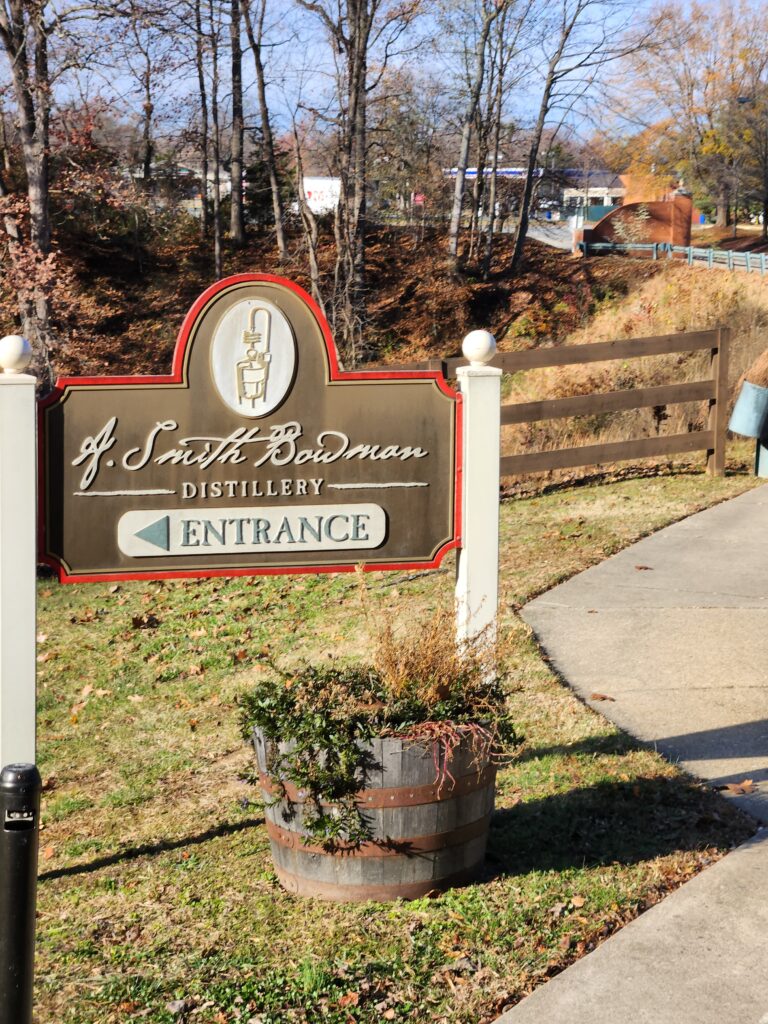
The A. Smith Bowman Distillery has a long history in Northern Virginia, starting when A. Smith Bowman moved to what is today’s Reston and started Sunset Hills Farm in 1927. This 4,000-acre farm employed 150 people and was a self-sufficient community. In 1934 he created a distillery to distill the excess corn and the spent grain was used to feed the cattle. The farm and distillery became a local tourist attraction along the Washington and Old Dominion Rail Line. Bowman’s two sons took over the operations when he died in 1952 and they expanded production and distribution with a peak in 1970. Eventually, the Bowman family sold most of their estate to Robert E. Simon, who used proceeds from selling Carnegie Hall to create the planned community of Reston. As the area became more urbanized, in 1988, the distillery moved south to Fredericksburg. Over time the distillery was purchased by various companies leading to today’s ownership by the Sazerac Company.
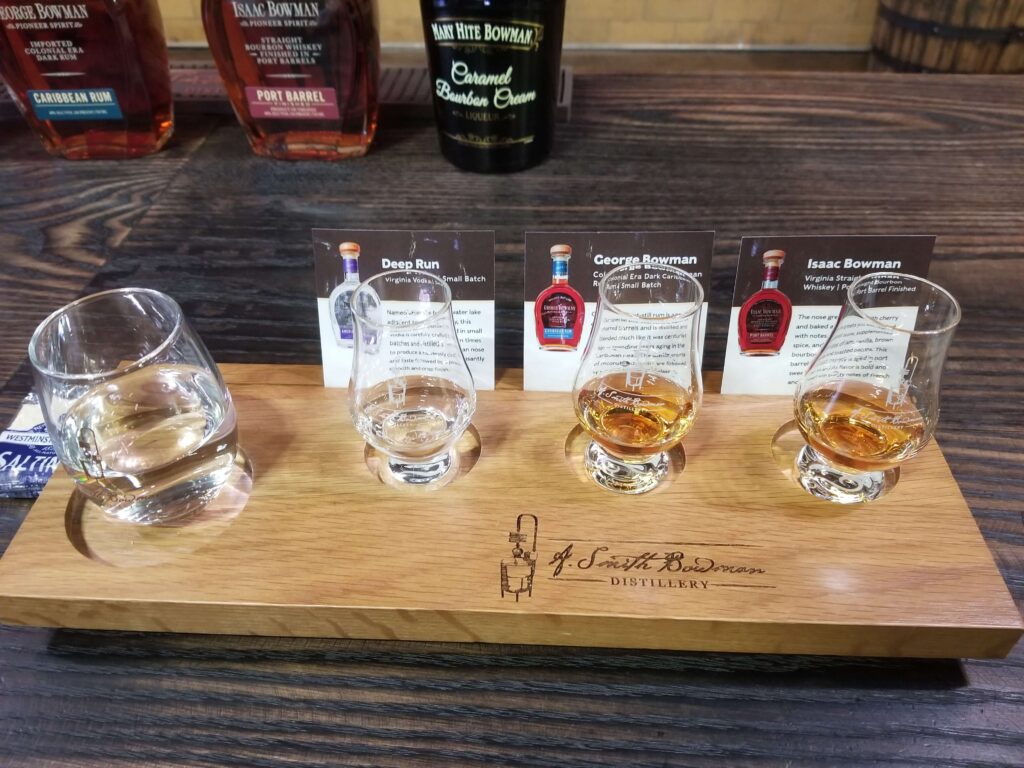
We tasting four well made spirits starting with the Deep Run Vodka, distilled seven times from a corn mash and charcoal filtered. Clean, peppery, and grassy. The George Bowman Colonial Era Dark Caribbean Rum is named for A. Smith’s German immigrant relative who first migrated to the Shenandoah Valley. This rum is distilled in Guyana using a pot still and local molasses and then imported and bottled in Fredericksburg. It’s a fantastic rum, honey, and nuts, with a chewy texture, and lasting finish. The Isaac Bowman Virginia Straight Bourbon Whiskey Port Barrel Finished is very complex showing baking spices, vanilla, dark fruit, nuts, and an approachable finish. Finally, we tasted the Mary Hite Bowman (George Bowman’s wife) Caramel Bourbon Cream Liqueur where the caramel is complimented by baking spices such as nutmeg and finishing with a pleasant kick.

Just like Puerto Rico Distillery, we’ve visited Dragon Distillery several times (easy since they are practically next door to each other) and am still savoring their Free State Collaboration with Flying Dog Brewery in the Dragon Dog Frederick Rye Whiskey. Dragon Distillery was the first East Coast distillery to launch an RTD product and two that we go to often are the Dragon’s Mule and Dragon’s Draft Bourbon & Cream Soda. For spirits, they have a very interesting and unique portfolio ranging from moonshine to rye and bourbon through gin and rum into infused spirits. One of these is the FigZilla Fig Infused Whiskey. Despite the name, vanilla overtakes the subtle fig which is most noticeable on the nose. A very smooth, drinkable whiskey. The Dwarven Morning Blend is for the rum-coffee lover as is the Sultan’s Surprise Toasted Coconut Rum which provides plenty of toasted coconut. Also, try the Snallygaster Blended Whiskey (Bourbon & Rye Blend) and the Joust Gin.
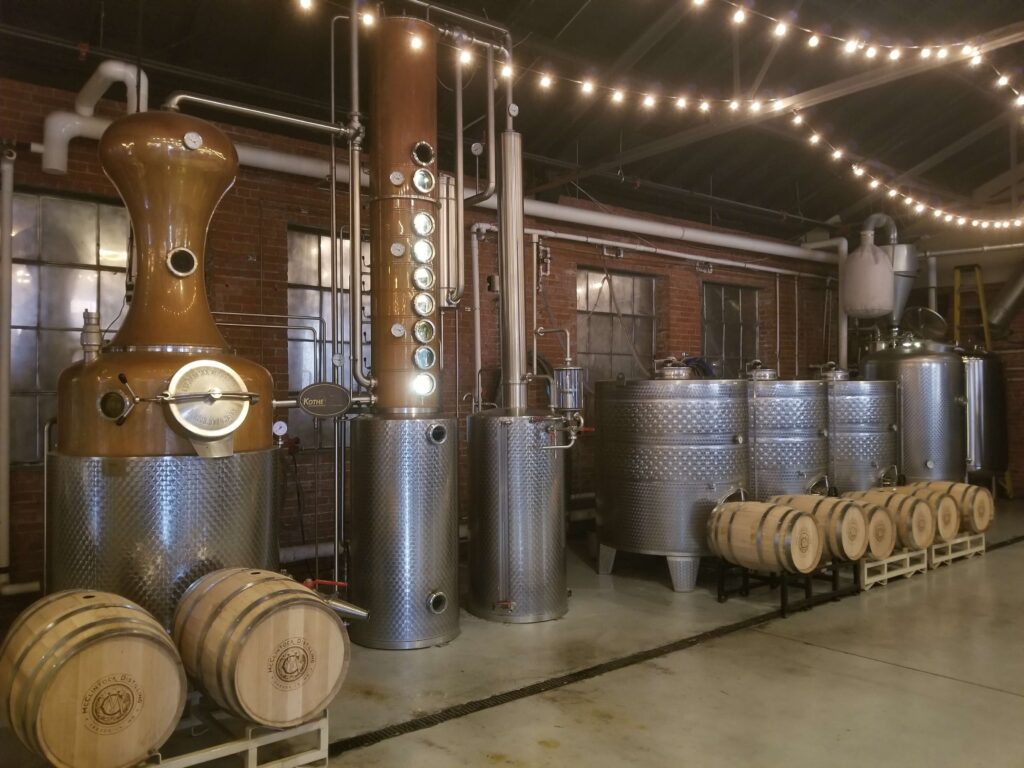
For 7 years, McClintock Distilling Company has operated in downtown Frederick MD producing a wide range of spirits from Maryland Rye Whiskey through bourbon and then vodka, gin, and cordials & liqueurs. They source organically and locally as much as possible and are the only certified organic distillery in Maryland. Their whiskeys are made from locally sourced heirloom grains whereas the gins and vodkas are made with only organic ingredients and the gins use non-GMO botanicals with no concentrates or extracts.
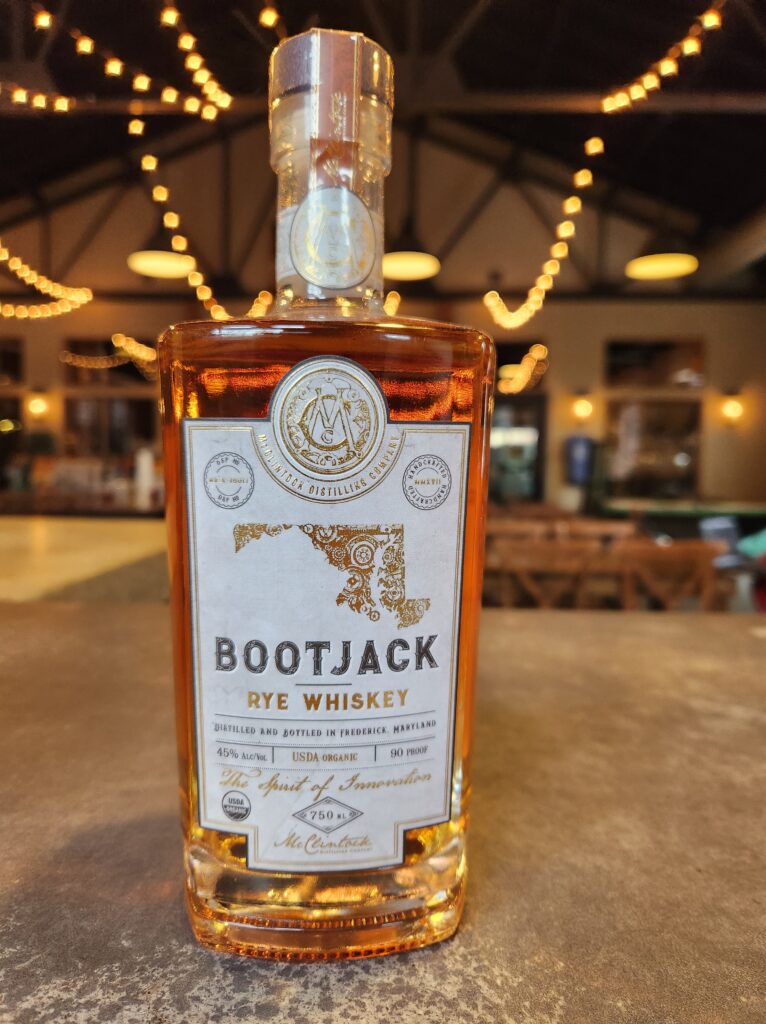
The Bootjack Rye Whiskey is made using 75% Danko Rye in a pre-prohibition mash bill, aged in white American oak barrels. It has a spicy rye profile up front which leads to a sweeter bready finish. The Matchstick Straight Bourbon Whiskey is set at exactly 51% corn (30% red fife wheat and 19% Danko Rye) and aged at least 2 years in oak. This is an intense bourbon, layers of honey, figs, tobacco, and a sweeter character at the tail. The Old Etzler Straight Rye Bottled in Bond whiskey spent five years in oak and has a sizzling profile with noticeable baking spices, vanilla, and black pepper. We tasted three gins, all made using a vapor infusion process. The Forager Gin is made using 21 botanicals inspired by native herbs found in the Appalachian Wilderness. The Gardener’s Gin differs in that it is aged in Madeira Wine Casks which provides a unique color. McClintock’s Reserve Gin is noted as the first American gin to be aged in Cognac barrels but this treatment doesn’t diminish the pine and citrus profile. And ask about their collaboration with Monacacy Brewing where they distill spent grain from various beers. The Brewtus Aged Spirit is made from the spent grain of a Monacacy Coffee Stout where the coffee aromas are compelling and chocolate on the finish. The Riot Rye IPA Aged Spirit is funky and a bit fruity.
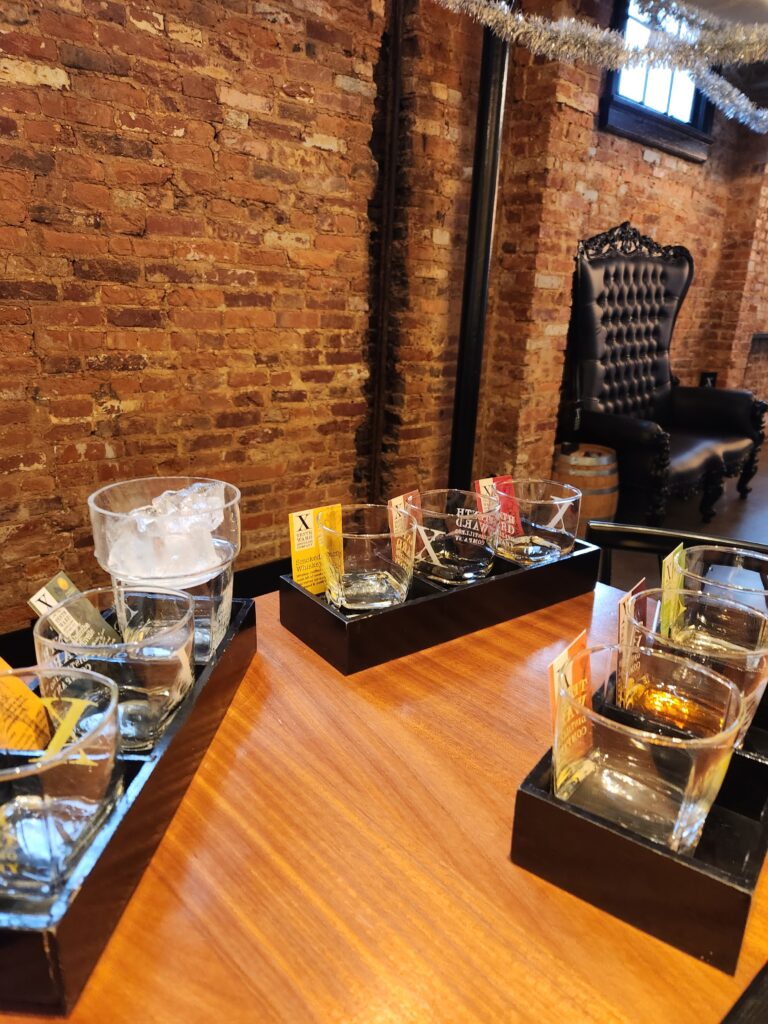
Tenth Ward Distilling Company was founded in 2016 by Monica Pearce and is located in what used to be the Tenth Ward of downtown Frederick, Maryland. They have a unique lineup that includes Absinthe Nouvelle, Genever Gin, Maryland Rye Whiskey, Smoked Bourbon, seasonal liqueurs, and canned cocktails. Their whiskey selection is distilled in-house, aged in Frederick and the grain base is 100% sourced from local farms. We need to start by discussing Maryland’s first and only absinthe — Absinthe Nouvelle. It is distilled with anise, fennel, grand wormwood, star anise, chrysanthemum, and mace and then naturally colored with petite wormwood, lemon balm, hyssop, and bergamot orange. It is excellent – no need for sugar just a little water. The Smoked Bourbon is a blend of 80% smoked corn and 20% malted barley aged in char #3 medium toast American White Oak barrels. It is another unique spirit = the smoke provides a peat-like character with a little campfire caramel. The Genever Style Gin is distilled from malted rye and cane spirit then vapor infused with juniper, angelica root, orris root, cardamom, elderflower, ginger root, persimmon, chicory root, and orange peel. Pine characters are prevalent finishing with bitter roots. I can envision a Negroni here. The final year-round spirit is the Maryland Rye Whiskey with 100% rye grown and malted in Frederick. This fits perfectly into the #mdryerevival happening now that highlights the historic nature of Maryland Rye Whiskey. There’s definitely a malty character intermingled with spices and pepper.
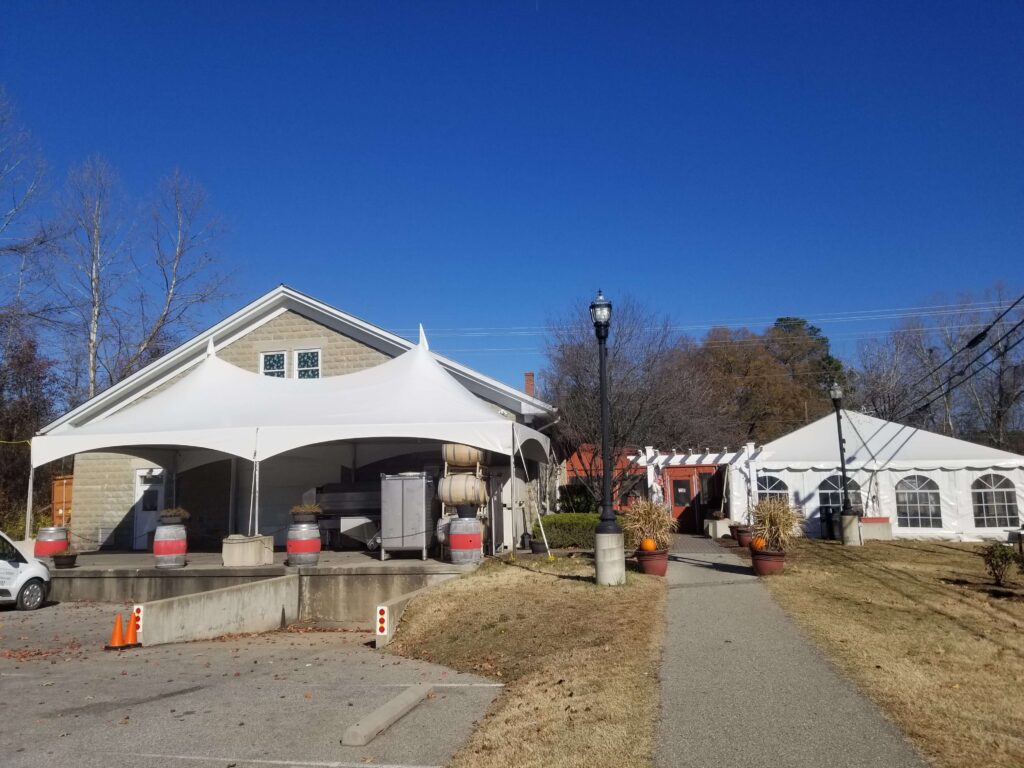
“The Southern Maryland Wine Growers Cooperative (SMWGC) cooperative was formed in 2007 as the region began to transition away from tobacco production to other agricultural pursuits…The SMWGC formed as the first agricultural cooperative in the state of Maryland leading the way for viticulture and future wineries. In 2009, the SMWGC officially opened the Port of Leonardtown Winery making it the first commercial winery in St. Mary’s County.” They may also be the only winegrower cooperative on the East Coast. The cooperative consists of 12 vineyards from St. Mary’s, Calvert, and Charles counties but they also source grapes from western Maryland and the Eastern Shore. In total, they source from 28 vineyards which help produce a wide range of wines from dry whites, reserve reds, sweet wines, port-styled wines, and apple wine – which they were fermented on our visit.
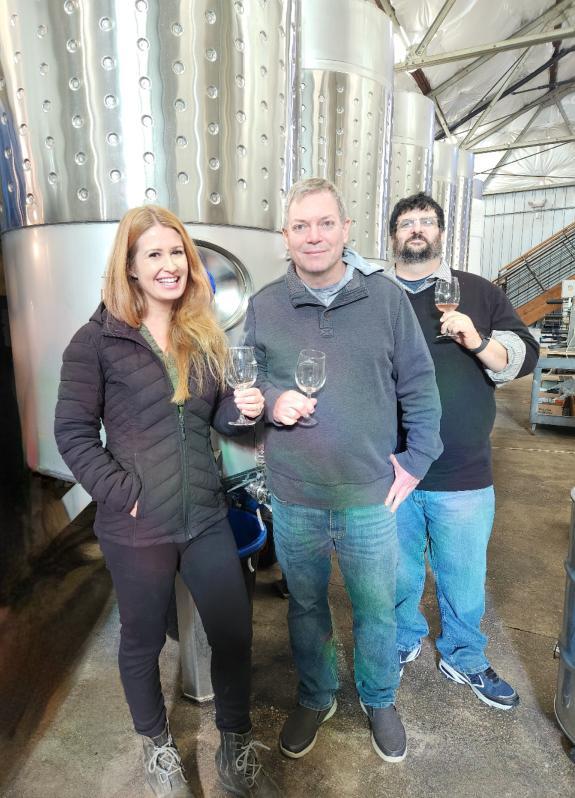
Ontario native Lauren Zimmerman has been the winemaker for the past eight years and has consistently produced innovative and award-winning wines. These include a dry Vidal Blanc, Albarino, and Governor’s Cup winning Chambourcin Reserve. In fact, 30% of the winery’s production is Chambourcin which goes into various blends, a lightly pressed Rosé, their Port of Leonardtown, and Chambourcin Reserve. During our visit we started with a tank-drawn Viognier and Chambourcin Rosé which led to a vertical of their Old Line Red Bordeaux blend which demonstrated the aging ability of these wines. In the tasting room, we started with a floral and surprisingly tannic dry 2022 Vidal Blanc eventually followed by a very delicious, medium-bodied, and complex Barbera Reserve. They also produce interesting 5-varietal blends like the 2022 Blanco Loco, the McIntosh Run apple wine, and various dessert wines. A wine for all palates. Since 95% of the wine is sold out of the tasting room, plan a long excursion into historic St. Mary’s County.
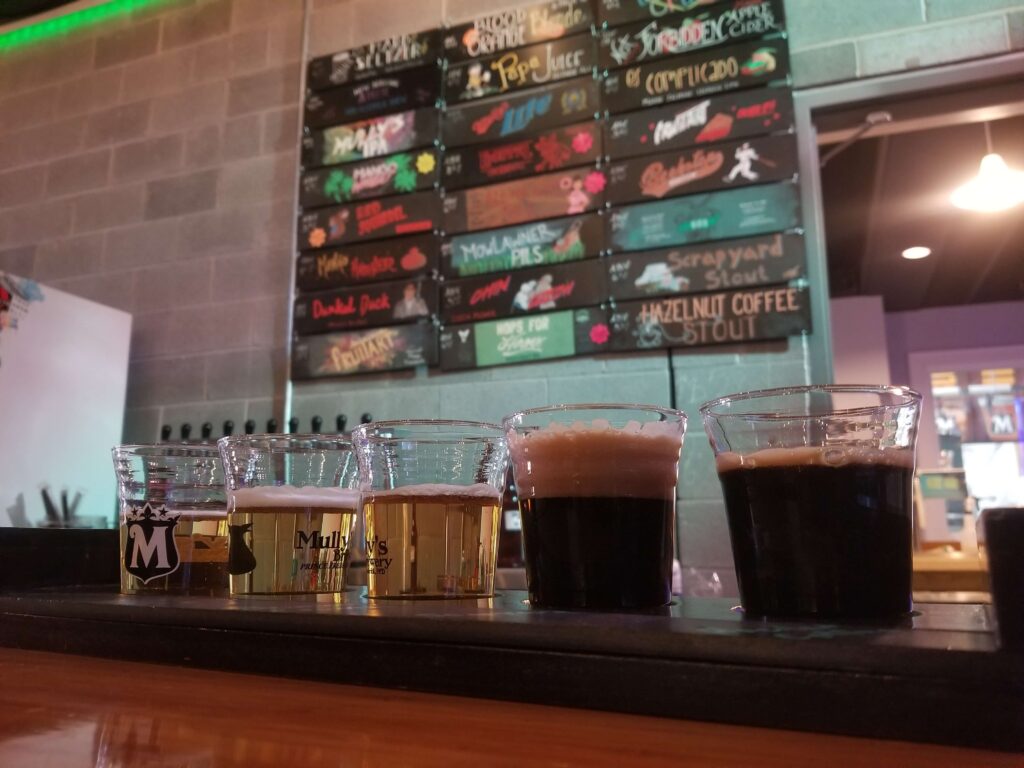
Mully’s Brewery is a family-owned and operated brewing facility that is a testament to hidden gems available throughout the American countryside. The brewery was started by Cindy and Jason Mullikin in 2012 and features a range of beer styles from lagers through sours to dry stouts. During our late November @BevFluence tour of southern Maryland, we visited and tasted through two flights of beers grasping the breadth of their portfolio. One of the most interesting was the Brunch Crunch – a Golden Ale brewed with coffee and cinnamon. Think of cinnamon toast with subtle coffee and a balanced finish. The Backstop Kolsch was very refreshing and clean as was the Not Forbidden Apple Cider. The Mowlawner Pils is a solid German Pilsner showing bready notes, while the Chin Czech Pilsner is weightier with more hop bitterness. The biggest surprises were the very well-made Red Squirrel Vienna Lager and Dunkel Buck Munich Dunkel. These beers were malty but sweet, and very balanced with the Dunkel providing a mocha and dry finish. Can’t wait to revisit a few of these with the mixed six-pack we purchased.
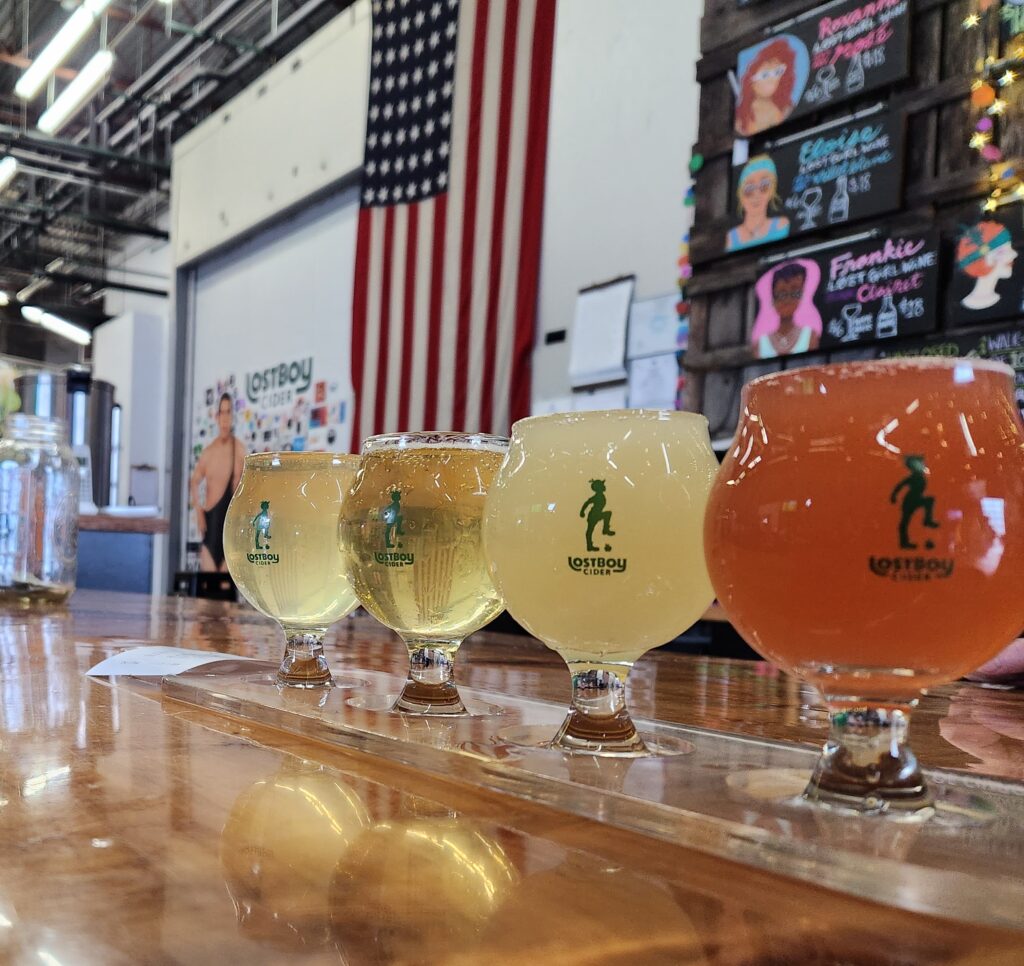
Lost Boy Cider is northern Virginia’s first urban cidery, serving Alexandria with a unique array of ciders from single varietal heirloom apples to cocktail inspired recipes. There’s usually at least 20 ciders on tap with pre-configured flights presented on the tasting board. We tasted through two flights starting with a Heirloom Series of the Wild Virginia (Albemarle Pippin, Arkansas Black, and golden russet apples), Small Apples (Hewes, Wickson, Ashmeads Kernel), Green and Gold (50% Rhode Island Greening and 50% Golden Delicious), and the Virginia Cyser (Apples, Wildflower, Clover Honey). With these ciders, you are presented with excellent representatives of the apple’s textural character ranging from sharpness to bitterness (tannic). The second flight was a mixed bag starting with the Pashionista (passion fruit and lemongrass) which was obviously tart with the soft lemon on the tail end. The Pura Vida (pineapples and spices) is very refreshing and we envisioned augmenting it with the Cotton & Reed Coconut Rum for the full expression. And the Spritz was the most pleasant surprise — made to replicate an Aperol Spritz with currants and house-grown bitters — and much better than my homemade blend of their Lost Boy Cider with a shot of Campari.















